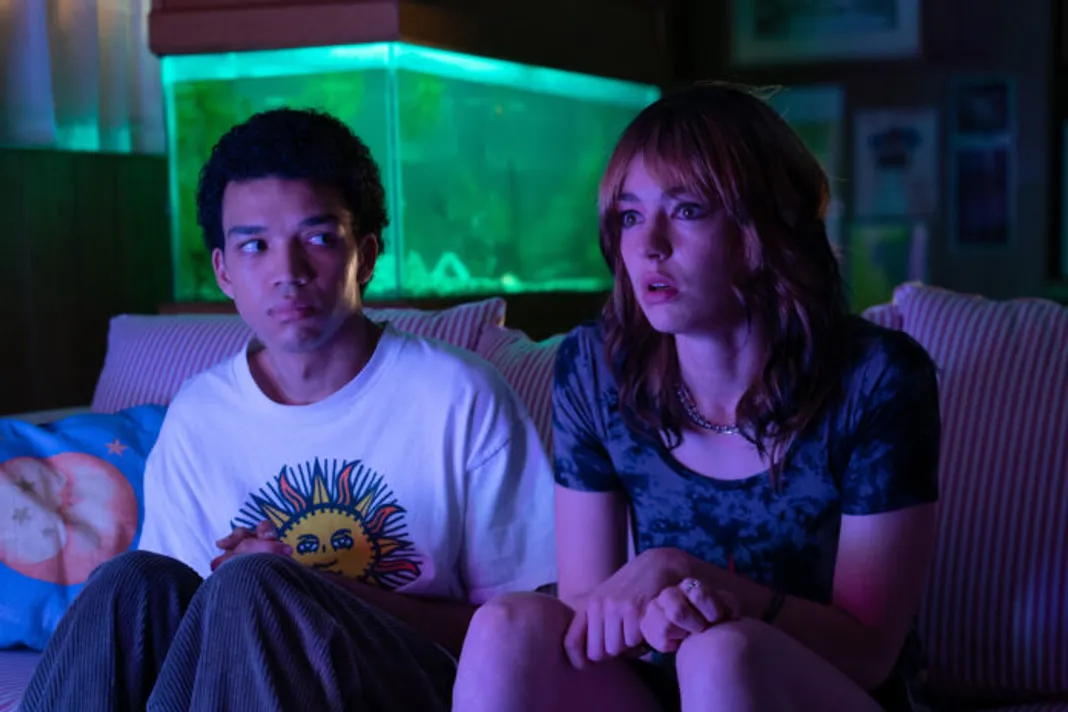In 2021, Director Jane Schoenbrun had a breakthrough with the viral indie-horror film, We’re All Going to the World’s Fair. Now, a few years on, they’re back with their stellar follow-up, I Saw the TV Glow, which blends horror and drama seamlessly. This visually stunning journey of self-discovery, notably produced by Emma Stone and husband Dave McCary under their Fruit Tree banner, journeys into themes of psychological dissociation and takes a look at how growing up in the suburbs has played a key role in these characters’ development.
We were lucky enough to sit in on a Q&A with Schoenbrun following the film to get their insights into their filmmaking process and what the film means to them so be sure to stick around to hear a bit more behind the scenes following the review!
Are you an avid A24 film lover? See some of the things that make them indispensable!
I Saw the TV Glow: Where fiction meets reality
Set in the 1990s, the movie revolves around Owen (played by Justice Smith), a teenager navigating suburban life. Everything changes when his classmate Maddy (portrayed by Brigette Lundy-Paine) introduces him to an enigmatic late-night TV show — “The Pink Opaque.” As the television’s soft glow illuminates the room, Owen’s perception of reality fractures, blurring the distinction between fiction and truth.
Navigating trans representation in I Saw the TV Glow
The film beautifully portrays the transformative journey of a transgender person toward self-discovery. Throughout the story, we see Owen suppressing his authentic self in his everyday existence. Given the limited media representation of queerness in the ‘90s, it’s solely through The Pink Opaque that he’s able to find solace and feel true to his real identity. The poignant ending showed Owen abandoning Maddie despite their pleas to join them back in “The Pink Opaque” and we see Owen as an older man, still at war with his own identity in denying what he discovered earlier, having it slowly eat at him and then continuously apologizing for burdening others with his internal struggles with identity as he ages.

During the Q&A, Schoenbrun discussed facing challenges depicting trans experiences within a commercial filmmaking system. They had to navigate different perspectives and hold space for their own valid decisions, even if others didn’t fully understand, which required resilience and the ability to defend their vision. Schoenbrun divulged, “I learned through my first film, World’s Fair, that the best way to talk about really intense things, even if they’re really intense trans things, is to not really worry about representation and to just try to use cinematic language to show how it felt, or capture how it felt.” They also went on to mention that the most personally challenging, yet rewarding, aspect was maintaining faith in their work and not compromising for the sake of legibility while making a deeply personal film with studio funding.
Fuzzy saturated visuals and static sounds straight off of a 90s VHS tape
Another standout aspect of this film was its visuals and sound design. The cinematography was expertly crafted and showcased a remarkable attention to detail throughout. Each frame was meticulously composed, capturing the essence of the ’90s setting with a nostalgic yet modern twist. The lighting, skillfully executed, added depth and emotion to every scene, creating a visual feast for the audience’s eyes. Furthermore, the choice of “hyper-saturated, 35mm, fuzzed-out VHS-style” visuals not only paid homage to the era but also lent a unique and captivating aesthetic to the film. The stellar soundtrack, featuring a curated selection of original tracks performed by renowned artists such as Caroline Polachek, Sloppy Jane, and Phoebe Bridgers, further elevated the film, immersing the audience in a world where music and visuals coalesced seamlessly.
Finding cinematic gems in suburban spaces for I Saw the TV Glow

One other notable aspect of the film was in the suburban setting which played a large role in the way that the story and character interactions unfolded. Schoenbrun discussed how location scouting was a major part of the creative process. They wanted to let the suburbs themselves lead and stay attuned to finding unique spaces that reflected their childhood experiences. Many memorable moments in their films came from finding locations that already looked a certain way, like an abandoned high school with strange signs they wanted to feature. Their gaze on suburban spaces growing up was always drawn to the “shitty, decrepit disrepair” and signs of rust or “sickness,” so they sought locations reflecting that liminal quality for this film as well.
Schoenbrun also discussed how shows like Buffy the Vampire Slayer deeply influenced their personal mythology and coming of age. They loved these shows growing up but also saw them as “teaching” a religion about suburban normality. The film pays homage to these influences through references, cameos from Buffy (and Nickelodeon’s Pete & Pete) actors, and by constructing an internal media mythology and storyline that speaks the language of 90s genre TV. Schoenbrun also mentioned, “Music is always going to be a big part of my films,” and wanted the film and soundtrack to capture the feeling of the teen soundtracks from films like Donnie Darko that captured a past era. Nostalgia for these childhood influences played a big role in sparking the ideas explored in the film.
Watch I Saw the TV Glow when it debuts in theaters nationwide on Friday, May 17, 2024!


